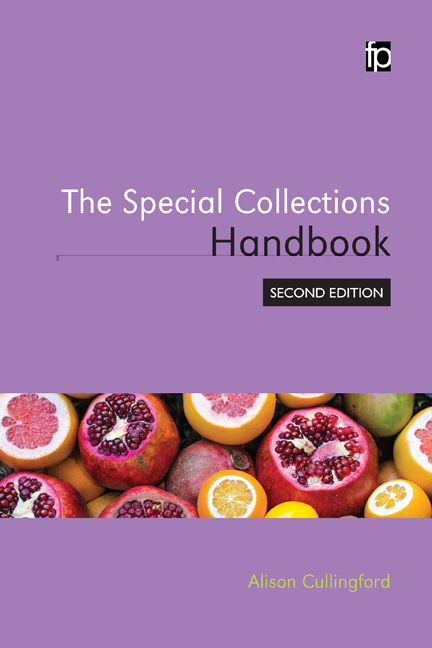Book contents
- Frontmatter
- Contents
- Preface and acknowledgements
- Introduction
- 1 The care of Special Collections
- 2 Emergency planning for Special Collections
- 3 Understanding objects in Special Collections
- 4 Acquiring and developing Special Collections
- 5 Cataloguing, description and metadata in Special Collections
- 6 Digitization and digital libraries in Special Collections
- 7 Legal and ethical issues in Special Collections
- 8 User services in Special Collections
- 9 Marketing and communications in Special Collections
- 10 Widening access to Special Collections
- 11 Organizational resources for Special Collections: space and people
- 12 Influencing and fund-raising for Special Collections
- Afterword: Special Collections futures
- Appendix A The Special Collections reference shelf
- Appendix B Skills for your Special Collections career
- Bibliography
- Index
6 - Digitization and digital libraries in Special Collections
- Frontmatter
- Contents
- Preface and acknowledgements
- Introduction
- 1 The care of Special Collections
- 2 Emergency planning for Special Collections
- 3 Understanding objects in Special Collections
- 4 Acquiring and developing Special Collections
- 5 Cataloguing, description and metadata in Special Collections
- 6 Digitization and digital libraries in Special Collections
- 7 Legal and ethical issues in Special Collections
- 8 User services in Special Collections
- 9 Marketing and communications in Special Collections
- 10 Widening access to Special Collections
- 11 Organizational resources for Special Collections: space and people
- 12 Influencing and fund-raising for Special Collections
- Afterword: Special Collections futures
- Appendix A The Special Collections reference shelf
- Appendix B Skills for your Special Collections career
- Bibliography
- Index
Summary
Introduction
Librarians are advised not to think of digital as an exception: the creation and management of digital collections are now business as usual for most services. Digital issues are therefore covered as they arise: find them via this book's index. We already discussed the preservation and history of digital objects. This chapter discusses some further aspects of digital collecting which do merit separate consideration.
Digitization: what and why.
Managing digitization projects.
Considering digital storage and access systems: the digital library and some alternatives.
This chapter concentrates on the management of digitization and digital files, rather than on technical and systems concerns, on the assumption that most libraries will have IT experts on their staff. For those who need it, guidance on the technical side can be found in ‘Further reading’.
Managing digitization
Digitization can be defined as the representation of an analogue original in a digital format (i.e. binary code). This process is also known as digitizing and, sometimes, digitalization (though this term is usually used to describe the computerization of social life or technologies). Digitized objects, unlike born-digital ones, therefore have an analogue counterpart.
From the perspective of many users, the act of image capture or ‘scanning it in’ is a simple one; why therefore are more collections not available in digital form? From the perspective of the library, however, image capture itself involves a range of choices, and is only one facet of ‘digitization’ as a management process.
Why digitize?
Digitizing collections can bring many benefits:
• Improved collections care. Digital versions can act as surrogates, taking the pressure off fragile originals.
• Meeting user demand. Users increasingly expect content to be digital.
• Increased public access at scale. If made available online, digital collections can reach people worldwide, easily, through their phones or devices.
• Educational use. For instance, they can be packaged as learning objects or used as part of an augmented reality programme (see Chapters 9 and 10).
• Marketing improvement. Most of the activities in Chapter 9 are made easier with the ready availability of digitized material.
- Type
- Chapter
- Information
- The Special Collections Handbook , pp. 113 - 126Publisher: FacetPrint publication year: 2016



